18 Types of Ducks Found in Ohio (with Pictures)
Last Updated on
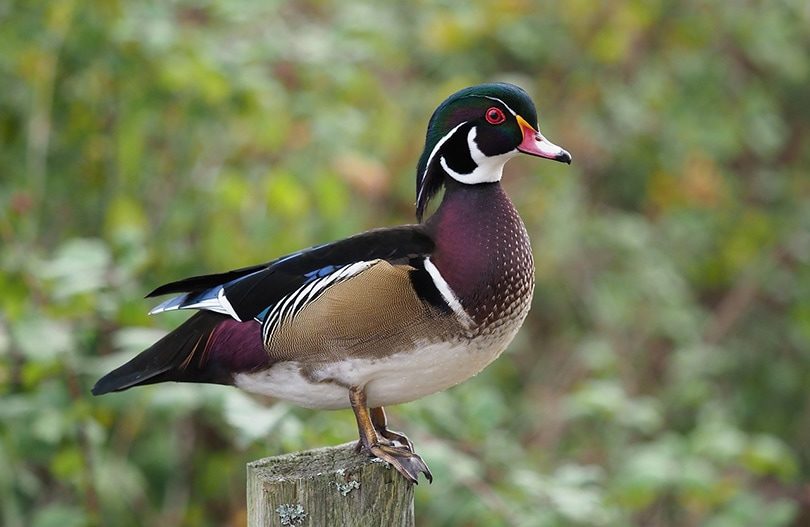
Ohio is home to some magnificent wildlife, including a variety of stunning waterfowl. You can see them flying in your area as the seasons change, hanging out beside water sources, or flying in flocks.
If you’re an Ohio native, or you’re just curious about state waterfowl, we have all the information you need. Here are 18 of the different duck breeds you could see in Ohio.

Types of Ducks in Ohio
There are several ducks that visit Ohio in warm months. Ohio is a place of abundant resources for these waterfowl, attracting ducks in every region.
In addition to wild flocks of ducks, many small- and large-scale farmers keep domesticated ducks around, too. Ducks provide a constant egg source, laying large eggs year-round—some of which are bigger than others.
What Are Diving Ducks?
A diving duck is on that propels itself underwater in order to get food.
What Are Dabbling Ducks?
Dabbing ducks are freshwater ducks that mainly feed in shallow water by upending.

The 9 Diving Ducks in Ohio
So, which duck species in Ohio dive under the water to score a meal? Here are nine.
1. Canvasback Duck
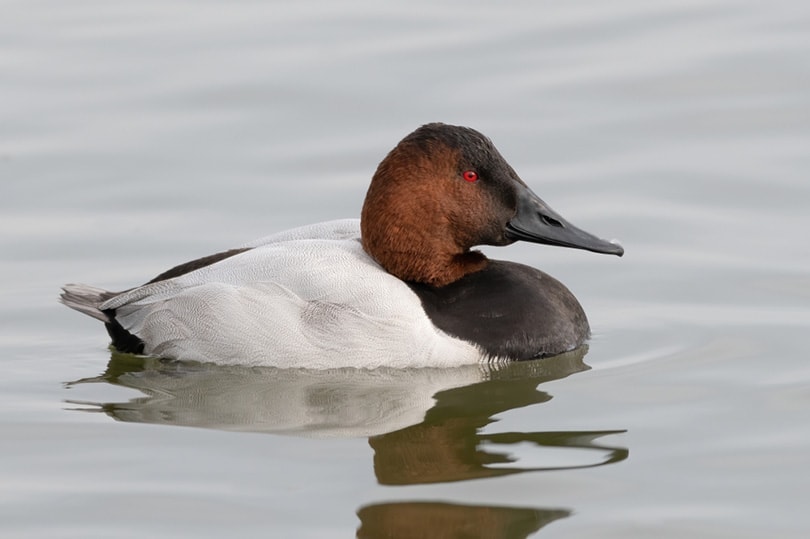
| Scientific Name: | Aythya valisineria |
| Color: | Chestnut, black, and white |
| Size: | 19 – 22 inches |
| Weight: | 1.9 – 3.5 pounds |
The lovely canvasback duck is the largest duck in North America. This distinct beauty has a chestnut-colored head and eyes, a black chest, and a pale gray-white body. Canvasbacks love open water and you can often find them in large groups therein.
- A canvasback can fly speeds up to 70 miles per hour, which is above average for waterfowl.
- It’s said that the oldest wild canvasback ever recorded was 22 years and seven months old.
- A canvasback can dive up to 30 feet.
2. Hooded Merganser Duck
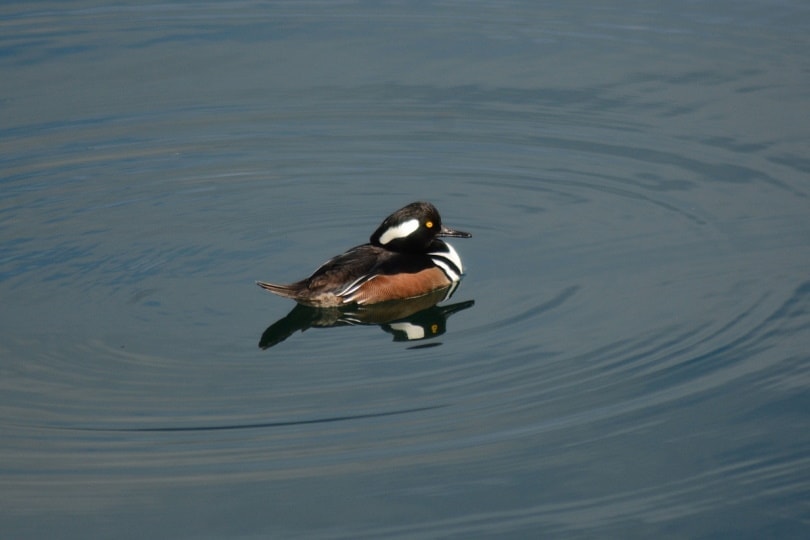
| Scientific Name: | Lophodytes cucullatus |
| Color: | Black, white, chestnut |
| Size: | 16 – 19 inches |
| Weight: | 1.5 – 2.5 pounds |
The hooded merganser is a duck you’ll see in Ohio, mostly around Lake Erie. These ducks have incredibly secretive lives. Scientists don’t know a lot about their mating process or private life, but these beautiful birds are observed all over North America.
These diving ducks are a sight to behold, with fanned collapsible crests and thin beaks. Males and females are distinguishable, as males have deeper tones with bold stripes and females are light tawny in color.
3. Lesser Scaup Duck

| Scientific Name: | Aythya affinis |
| Color: | Black, gray, white |
| Size: | 15 – 18 inches |
| Weight: | 1.5 – 2 pounds |
The lesser scaup is a small duck that loves Ohio for its lakes, ponds, and marshes. They usually live in flocks of up to 50 birds and rely on each other during warm and cold months. They love to nest near thick vegetations by water sources.
The lesser scaup goes by many names, like little bluebill or broadbill, due to their distinctive blue bill. Comparing the greater to the lesser scaup might be difficult for the untrained eye, but the trick is that the lesser scaup usually has a thinner, narrower profile.
4. Greater Scaup Duck

| Scientific Name: | Aythya marila |
| Color: | Black, white |
| Size: | 28 – 33 inches |
| Weight: | 1 – 3 pounds |
The greater scaup, otherwise known as the bluebill, is a mid-sized diving duck slightly larger than their relative mentioned above—the lesser scaup. While most commonly in Alaska and Northern Canada, these ducks do find their way to the upper parts of Ohio—they even wind up in Europe.
The greater scaup has an evenly rounded head and contrasting yellow eyes. Males are generally black and white while females are brown and tawny tones. These birds stay monogamous only during the breeding season, gaining a new mate the year after.
5. Pied-Billed Grebe Duck
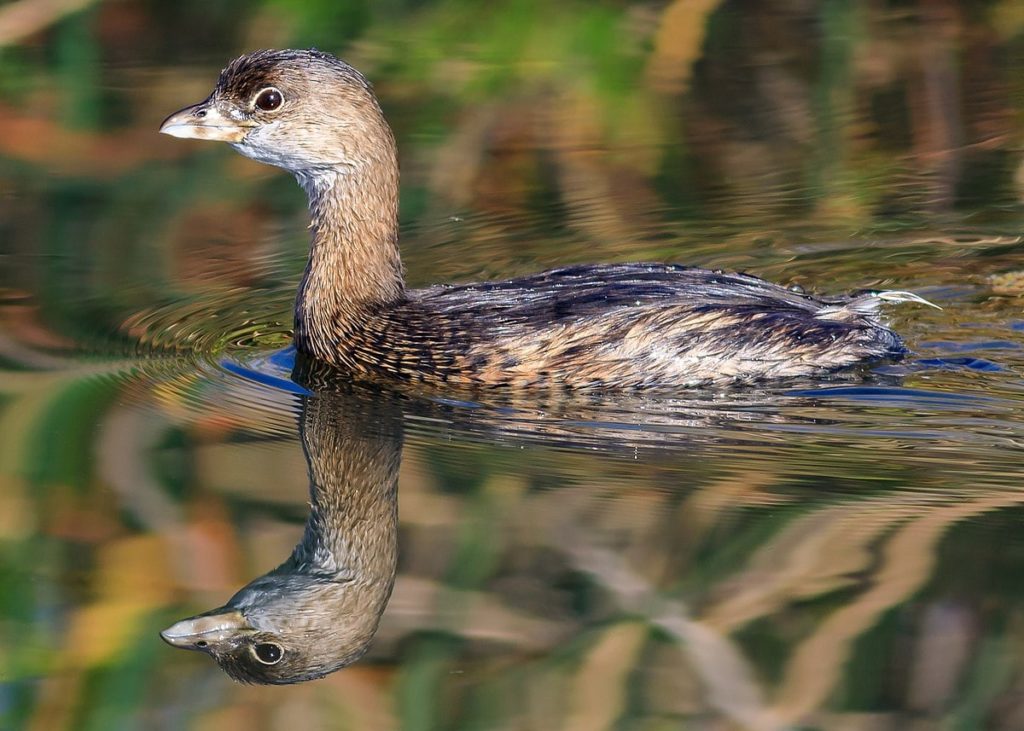
| Scientific Name: | Podilymbus Podiceps |
| Color: | Brown |
| Size: | 12 – 15 inches |
| Weight: | 15 ounces |
The pied-billed grebe is an itty-bitty duck with a youthful expression its whole life through. This species is the last species in the genus Podilymbus, outliving its close relatives. Typically, these ducks inhabit ponds all around the Americas.
Because of their neutral coloring, it’s hard to tell male and female pied-billed grebe ducks apart. These water birds are dark brown to nearly cream with a patchy tone pattern. Interestingly, they swim like ducks but do not possess webbed feet.
6. Red-Breasted Merganser Duck

| Scientific Name: | Mergus serrator |
| Color: | Cinnamon, white, green |
| Size: | 1.7 – 2.1 feet |
| Weight: | 2.0 – 2.5 pounds |
The red-breasted merganser is a sawbill duck that is very common in parts of North America—Ohio being a particularly favorite summering location. These birds stand tall with sprout-like hairdos.
These ducks are unique because their bills have serrations on them so they can rip and tear into prey. Their beaks are long and thin, with a beautiful orange that contrasts with their shaggy emerald green head and multicolor bodies.
7. Redhead Duck
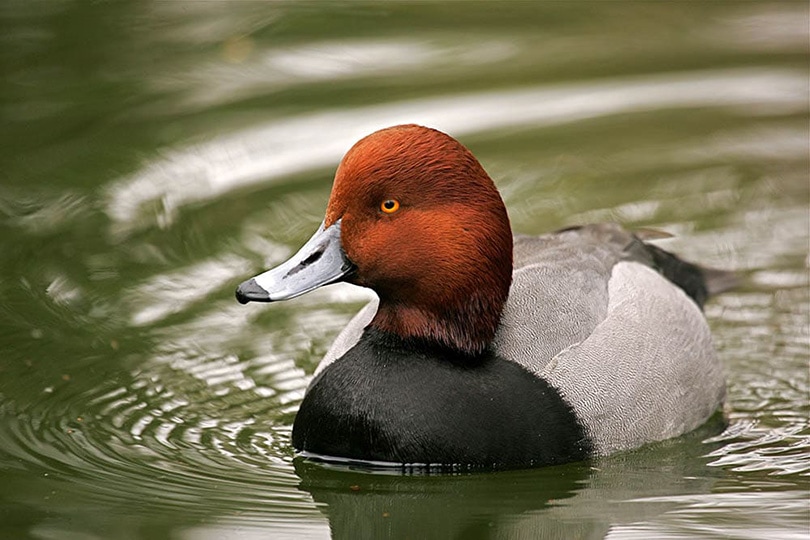
| Scientific Name: | Aythua americana |
| Color: | Auburn, black, gray |
| Size: | 20 inches |
| Weight: | 2 – 2.5 pounds |
The Redhead duck visits Ohio yearly, among other states. Interestingly, the Redhead scientific name derives from the Greek seabird mentioned by Aristotle. So, their lineage has a little bit of rich history.
They have auburn heads and deep black chests—instantly recognizable to any duck fanatic. Females are slightly less eye-catchy than the males, touting a cinnamon sugar color. These birds prefer calm, still water, like marshes.
8. Ring-Necked Duck

| Scientific Name: | Aythya collaris |
| Color: | Black and gray |
| Size: | 17 – 18 inches |
| Weight: | 1.5 – 1.7 pounds |
The ring-necked duck comes to Ohio to enjoy stagnant, shallow waters. They prefer small, intimate water spaces over large ones, as they tend to be quiet, private ducks.
These ducks have very bold coloring, males having deep black and light gray patterning on them. Females are dark brown with a nearly chocolate head—both genders have penetrating yellow eyes. Ring-necked ducks have never been observed in large groups nor have they been hunted.
9. Ruddy Duck

| Scientific Name: | Oxyura jamaicensis |
| Color: | Black, brown |
| Size: | 16 – 17 inches |
| Weight: | 0.6 – 1.8 pounds |
The ruddy duck is a pretty noticeable fellow and they aren’t shy in the United States. These are highly common ducks—you’ve probably seen a few yourself. These ducks love marshes, ponds, and lakes but they will fly towards salt bays in the winter.
Male ruddy ducks have a bright blue beak and dark brown feathering. Females have a brown beak with plain brown feathering. Males have an erect, straight tail while a female’s tail feathers point south—but both are stiff.
The 9 Dabbling Ducks in Ohio
What ducks are feeding in shallow waters? Let’s take a look at these nine dabbling ducks in Ohio.
10. American Black Duck
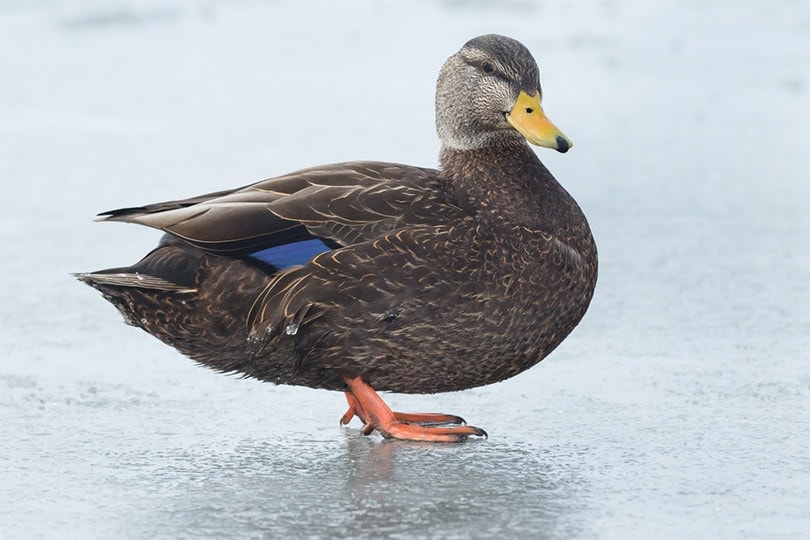
| Scientific Name: | Anas rubripes |
| Color: | Dark brown |
| Size: | 35 – 37 inches |
| Weight: | 1.6 – 3.6 pounds |
The American black duck is one of the heaviest duck species, existing in the genus Anas. They love to hang out in Ohio’s wetlands like river islands and beaver ponds. Unfortunately, the number of this species has decreased quite a bit in passing years.
The American black duck is a lovely charcoal feathered duck with electric blue undertones during flight. They have a distinguishable yellow beak and impressive wingspans. These birds tend to be very shy and moderately territorial.
11. American Wigeon Duck
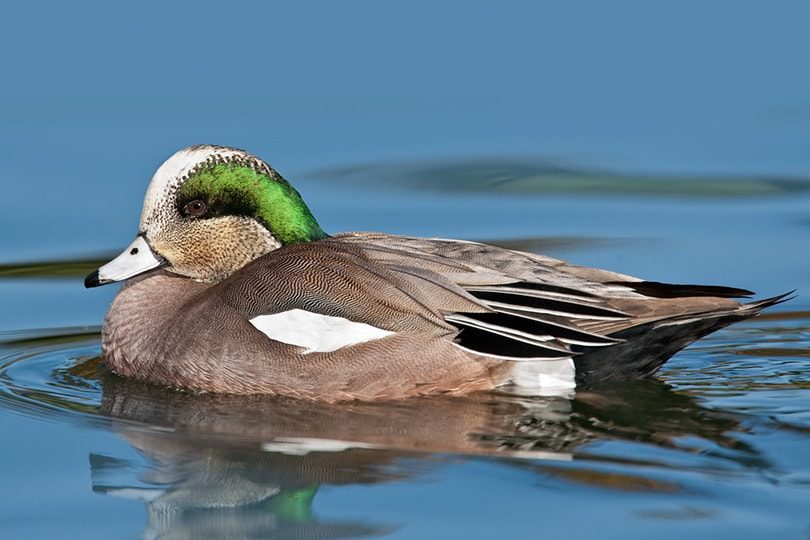
| Scientific Name: | Mareca americana |
| Color: | Brown, green, cinnamon |
| Size: | 17 – 23 inches |
| Weight: | 2.5 – 3 pounds |
The American wigeon prefers the slow-moving rivers and estuaries Ohio offers. Like many other ducks, they are omnivorous, but this breed really prefers snacking on plants. They are huge fans of Ohio natives like cattail, duckweed, and sedge.
Males and females look very similar—the guys are just a bit flashier. Males are cinnamon-bodied with a white top and a bright iridescent green patch on the head. There is a smudge around their eyes, making them appear exaggerated.
12. Blue-Winged Teal Duck
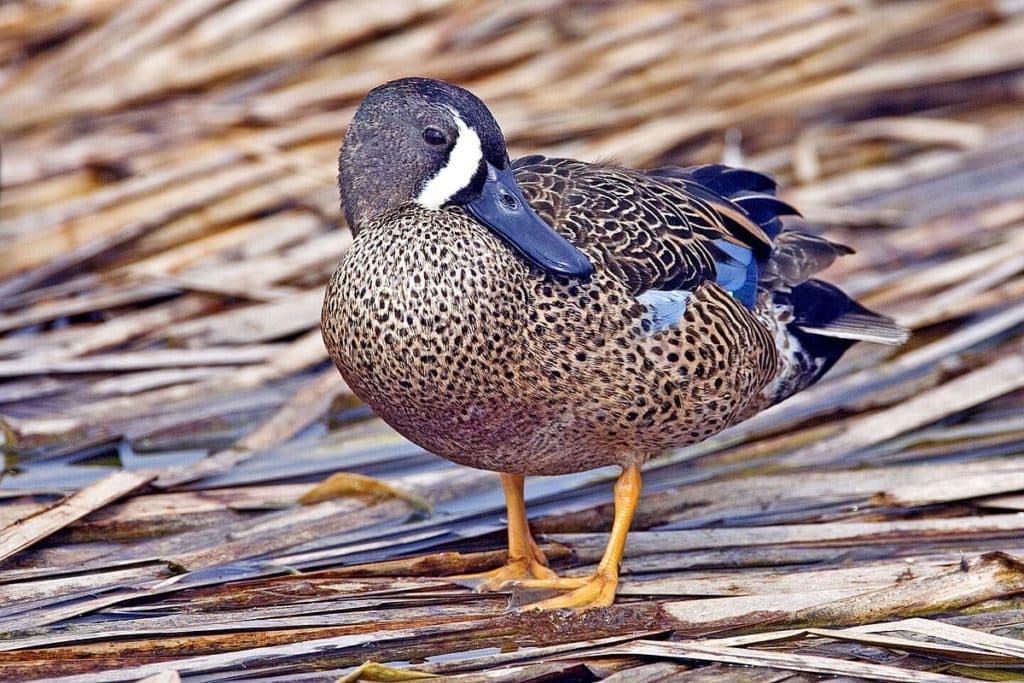
| Scientific Name: | Anas discors |
| Color: | Chocolate, brown, tan, white |
| Size: | 15 – 16 inches |
| Weight: | 11 – 13 ounces |
Blue-winged teals are sleek, handsome ducks that are roughly the size of an American crow. These ducks prefer calmer waters such as marshes and small lakes. They prefer grassy water banks for shelter and nesting.
The blue-winged teal gets its from the teal on its wings. These birds are somewhat unremarkable until flight, touting basic neutral speckled feathers. However, when they take off, males show their distinct color. Females do not share this trait.
13. Gadwall Duck
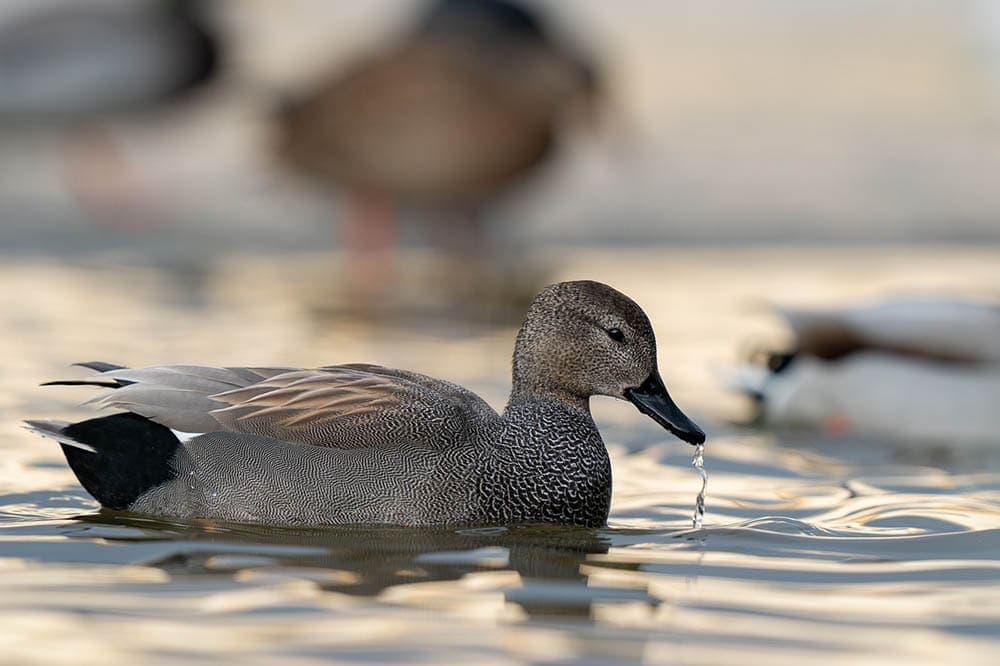
| Scientific Name: | Mareca strepera |
| Color: | Gray-brown |
| Size: | 20 inches |
| Weight: | 1.5 – 2 pounds |
The gadwall is a familiar face in Ohio throughout the warm months. These omnivores will eat some insects, but they prefer aquatic plants. These ducks absolutely adore the flooded croplands of northern Ohio, forests, and deep open water.
While you can tell males and females apart, their color distribution is slightly different. Both genders are gray-brown in color with patches on their hindquarters. Funny fact—the gadwall has been known to swoop food from another diver duck as they surface.
14. Green-Winged Teal Duck

| Scientific Name: | Anas carolinesis |
| Color: | Teal, cinnamon, gray |
| Size: | 12.2 – 15.3 inches |
| Weight: | 11 – 13 ounces |
The adorable green-winged teal is a very prevalent duck all over—being quite a familiar face. For a long time, this breed was considered conspecific with Eurasian teals, but in recent times, they say this isn’t the case. These ducks prefer inhabiting marshes, rivers, and bays with floating vegetation.
The green-winged teal is a tiny duck, being the smallest dabbling duck in North America. They have short legs and necks with stocky bodies. Males have bold coloring, with cinnamon and emerald heads. Females have scattered neutral-toned feathering.
15. Mallard Duck

| Scientific Name: | Anas platyrhynchos |
| Color: | Green, black, gray |
| Size: | 20-26 inches |
| Weight: | 1.6-3.5 pounds |
The mallard might be one of the most classic North American ducks of all time. Thanks to its flashy markings, it’s a hallmark of ducks everywhere, appearing in video games, movies, postcards, and paintings. But in real life, it lives in almost any freshwater source in Ohio—these birds are plentiful.
The mallard has a bright emerald green head and gray body with a vivid yellow beak. Females are less attractive, with neutral feathering and a strip of electric blue on the hind flanks. These ducks can fly up to 70 miles per hour, which is very impressive!
16. Northern Pintail Duck

| Scientific Name: | Anas acuta |
| Color: | White, tan, gray-brown |
| Size: | 25 – 29 inches |
| Weight: | 1 – 3 pounds |
You can find the Northern pintail all around North America, as it is a very prevalent duck species. These ducks love to hang out around agricultural fields, salt marshes, brackish wetlands, and grasslands. These ducks are big fans of crustaceans and aquatic insects.
These ducks are named for their uniquely thin, straight tail. During the breeding season, it gets even longer and pointier to attract a suitor. These ducks are not monogamous and find a new mate annually.
17. Northern Shoveler Duck

| Scientific Name: | Spatula clypeata |
| Color: | Green, auburn, gray, black |
| Size: | 18 – 19 inches |
| Weight: | 1 – 2 pounds |
The northern shoveler’s name might make sense when you see a picture. Remarkably, these ducks have a long-scooped beak to pick up invertebrates, seeds, and small crustaceans in marshes, ponds, and wetlands.
Males have an iridescent green head, bright white chest, and auburn flanks. Females range from buff to brown in color—usually a combination. What’s really neat is that their oddly shaped bill has over 110 fine projections on their beaks to sift food in the water.
18. Wood Duck

| Scientific Name: | Aix sponsa |
| Color: | Chestnut, green, gray, white, black |
| Size: | 19 – 21 inches |
| Weight: | 1 pound |
The wood duck is also called the Carolina duck, though it travels outside of that habitat to frequent areas in North America—including Ohio. These ducks hang out in ponds, lakes, rivers, and streams. They like a good variety, so you can find them anywhere from water to forests.
Male wood ducks are highly recognizable with flamboyant features—like iridescent chestnut and green coloring with penetrating red eyes. They are the most colorful North American duck. Females have a much humbler look with low-setting bodies and light to dark brown feathering with white tips.

In Conclusion
As you can see, there is no shortage of duck species in the Buckeye State. You have a variety of colors, sizes, migratory patterns, and habitat preferences. It’s so interesting to see all nature has to offer in the natural world.
If you have a love for ducks in the wild, Ohio is surely a place to explore or travel to when exploring waterfowl.
Featured Image Credit: wam17, Pixabay
About the Author Ashley Bates
Ashley Bates is animal writer and enthusiast who is currently studying the art of animal therapy. A mother to four human children— and 23 furry and feathery kids, too – Ashley volunteers at local shelters, advocates for animal well-being, and rescues every creature she finds. Ashley's mission is to create awareness and education about animals of all shapes and sizes to promote proper care and respect.
Related Articles:
Monocular vs Telescope: Differences Explained (With Pictures)
10 Types of Hummingbirds in Arkansas (With Pictures)
8 Types of Hummingbirds in Nebraska (With Pictures)
5 Types of Hummingbirds in Idaho (With Pictures)
3 Types of Hummingbirds in Mississippi (With Pictures)
8 Types of Hummingbirds in Kansas (With Pictures)
5 Types of Hummingbirds in West Virginia (With Pictures)
5 Types of Hummingbirds in Ohio (With Pictures)
